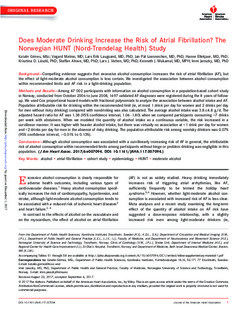| dc.contributor.author | Gmes, Katalin | |
| dc.contributor.author | Malmo, Vegard | |
| dc.contributor.author | Laugsand, Lars Erik | |
| dc.contributor.author | Loennechen, Jan Pl | |
| dc.contributor.author | Ellekjaer, Hanne | |
| dc.contributor.author | Lszl, Krisztina D | |
| dc.contributor.author | Ahnve, Staffan | |
| dc.contributor.author | Vatten, Lars J | |
| dc.contributor.author | Mukamal, Kenneth J | |
| dc.contributor.author | Janszky, Imre | |
| dc.date.accessioned | 2017-12-02T07:30:49Z | |
| dc.date.available | 2017-12-02T07:30:49Z | |
| dc.date.created | 2017-11-20T12:19:50Z | |
| dc.date.issued | 2017 | |
| dc.identifier.issn | 2047-9980 | |
| dc.identifier.uri | http://hdl.handle.net/11250/2468811 | |
| dc.description.abstract | Background Compelling evidence suggests that excessive alcohol consumption increases the risk of atrial fibrillation (AF), but the effect of light‐moderate alcohol consumption is less certain. We investigated the association between alcohol consumption within recommended limits and AF risk in a light‐drinking population.
Methods and Results Among 47 002 participants with information on alcohol consumption in a population‐based cohort study in Norway, conducted from October 2006 to June 2008, 1697 validated AF diagnoses were registered during the 8 years of follow‐up. We used Cox proportional hazard models with fractional polynomials to analyze the association between alcohol intake and AF. Population attributable risk for drinking within the recommended limit (ie, at most 1 drink per day for women and 2 drinks per day for men without risky drinking) compared with nondrinking was also calculated. The average alcohol intake was 3.8±4.8 g/d. The adjusted hazard ratio for AF was 1.38 (95% confidence interval, 1.06–1.80) when we compared participants consuming >7 drinks per week with abstainers. When we modeled the quantity of alcohol intake as a continuous variable, the risk increased in a curvilinear manner. It was higher with heavier alcohol intake, but there was virtually no association at <1 drink per day for women and <2 drinks per day for men in the absence of risky drinking. The population attributable risk among nonrisky drinkers was 0.07% (95% confidence interval, −0.01% to 0.13%).
Conclusions Although alcohol consumption was associated with a curvilinearly increasing risk of AF in general, the attributable risk of alcohol consumption within recommended limits among participants without binge or problem drinking was negligible in this population. | nb_NO |
| dc.language.iso | eng | nb_NO |
| dc.publisher | Wiley Open Access and American Heart Association | nb_NO |
| dc.rights | Navngivelse-Ikkekommersiell 4.0 Internasjonal | * |
| dc.rights.uri | http://creativecommons.org/licenses/by-nc/4.0/deed.no | * |
| dc.title | Does moderate drinking increase the risk of atrial fibrillation? The norwegian HUNT (Nord-Trøndelag Health) study | nb_NO |
| dc.type | Journal article | nb_NO |
| dc.type | Peer reviewed | nb_NO |
| dc.description.version | publishedVersion | nb_NO |
| dc.source.volume | 6 | nb_NO |
| dc.source.journal | Journal of the American Heart Association | nb_NO |
| dc.source.issue | 10 | nb_NO |
| dc.identifier.doi | 10.1161/JAHA.117.007094 | |
| dc.identifier.cristin | 1516014 | |
| dc.relation.project | Vetenskapsrådet: 2021005208 | nb_NO |
| dc.description.localcode | © 2017 The Authors. Published on behalf of the American Heart Association, Inc., by Wiley. This is an open access article under the terms of the Creative Commons Attribution-NonCommercial License, which permits use, distribution and reproduction in any medium, provided the original work is properly cited and is not used for commercial purposes. | nb_NO |
| cristin.unitcode | 194,65,20,0 | |
| cristin.unitname | Institutt for samfunnsmedisin og sykepleie | |
| cristin.ispublished | true | |
| cristin.fulltext | original | |
| cristin.qualitycode | 1 | |

